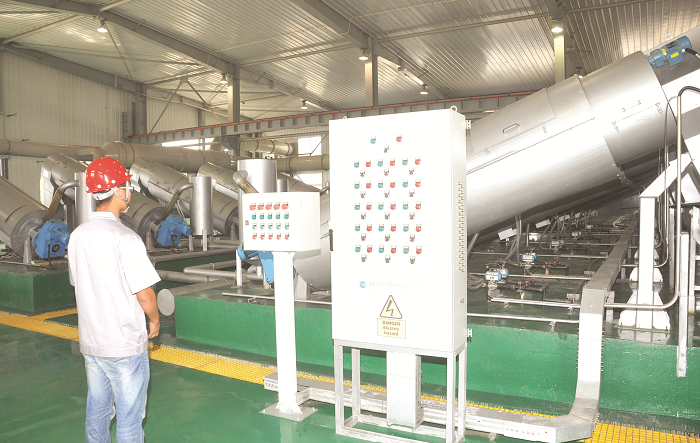
‘Lavender Hill’ plant to generate power, compost
The newly constructed Mudor faecal treatment plant in Accra will, apart from effectively decommissioning the over a-century-old infamous Lavender Hill, generate about 500 kilowatts (KW) of power from the treatment process, the Project Manager of the plant, Ing. Mrs Florence Cobbold, has said.
Advertisement
In an interview with the Daily Graphic in Accra yesterday, Mrs Cobbold said more electricity would be generated in the second phase of the project to bring the total power generation to about 7.5 megawatts (MW).
Although Lavender Hill, a waste treatment facility at Korle Gonno in Accra, broke down years ago, it was the main disposal site for liquid waste and saw over 200 cesspit trucks empty their contents directly into the sea daily.
The construction of the Mudor plant began on September 9, 2014 and was originally scheduled for completion in August 2016 but it was finally completed in October and inaugurated by President John Mahama last Friday.
Inaugurating the facility, President Mahama said; "Today, we are ending an ugly spectacle. Today is a particularly happy day for me because Lavender Hill is going to be closed today."
He stated that ‘Lavender Hill’ had been a scar on the nation, adding, "I always felt a sense of shame when these issues were raised by our international partners or even tourists who visit our country.”
Ing. Cobbold said “the second phase of the project will involve co-digestion of the sludge (attaching digesters to the facility). This will come after the pre-treatment phase that will involve separating the solid from the liquid and the sludge that we will collect is what we are hoping to co-digest (put in another form to generate more electricity). But for this plant, this first phase, it is just about half megawatt of power that we are going to generate.”
Another benefit that would be derived from the plant would be compost for farming purposes, she said, adding that “even if it is on a small-scale, we will do the composting, but we are going to get sludge from the other side”.
Ing. Cobbold noted that the plant’s management was still contemplating how to utilise the treated effluent as it needed acceptance by the public to be put to the prescribed use. “The treated waste water can also be used for irrigation, car washing and aquaculture if the right systems are put in place,” she said.
End of an era
It was specifically to decommission the broken down waste treatment plant which had earned the tag ‘Lavender Hill’ because of the stench that emanated from it but had existed for 110 years that the Mudor treatment plant was constructed.
The US$80-million facility was put up by the Nanjig Wonders Environmental Protection Company Limited (NWEPCL), a Chinese construction firm, for Sewerage Systems Ghana Limited (SSGL), the operators, on the basis of a public/private partnership (PPP) with the government through the Ministry of Local Government and Rural Development.
Mudor has the capacity to treat between 2,000 cubic metres and 2,400 cubic metres of faecal or liquid waste daily from over 200 cesspit emptiers which will be able to hygienically dispose of their waste at the plant at any time of the day since the plant will operate a 24-hour system.
However, the emptiers will continue to pay their fees to the Accra Metropolitan Assembly (AMA), but the ministry will in turn pay the operators of the waste facility on a monthly basis.
The Mudor Plant
The Mudor treatment plant occupies a land area of 3.03 hectares and comprises a block of offices which also house a well-equipped laboratory, Grid Screening machines, a 5,500 cubic metre storage tank, a machine for odour control and an upflow anaerobic sludge blanket (UASB) comprising four tanks with the capacity of 1,700 cubic metres each where biological treatment will take place.
Explaining how the power would be generated from the plant, Ing. Cobbold said biogas, comprising methane, carbon dioxide and hydrogen sulphide, would be extracted from the UASB treatment process, after which it would be cleaned for methane to generate electricity mainly to run the plant, with any surplus going to the national grid.
“The gas will be cleaned in the three off-white desulphurisation tanks and the expected volume of gas to be generated is about 7,000 cubic metres, which is expected to produce between 400kw and 500kw of electricity.
“The treatment plant will also operate an ultraviolet (UV) system and has two huge concrete clear water tanks that will hold the treated water that will be released into the sea or lagoon after it has been certified as meeting acceptable standards,” she stated.
Officials at the site indicated that the globally accepted level of biological oxygen demand (BOD) in waste water is below 50mg/l, while for chemical oxygen demand (COD), it is supposed to be below 120mg/l, but said the BOD in the Korle Lagoon was over 3,265mg/l due to excessive pollution.



